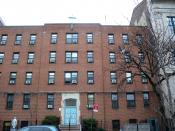It is necessary for the government to impose a certain amount of power and control on its citizens in order for a society to function properly. However, too much power and control in a society eliminates the freedom of the residents, forbidding them to live an ordinary life. In the dystopic futuristic novel, The Handmaid's Tale, Margaret Atwood demonstrates the theme of power and control through an oppressive society called the Republic of Gilead. The government establishes power and control through the use of the Wall, military control, the Salvaging, and the Particicution. The Aunts indoctrinate the Handmaids and control them by using fear and intimidation. The Patriarchal society allows the Commanders to hold immense power over the citizens, while the Commander's Wives hold the power in the household. Generally, the Handmaids do not hold very much power because they are of a lower class in the Patriarchal society.
The Republic of Gilead institutes power and control in society, therefore forcing its residents into submission and leaving them completely helpless in a totalitarian regime.
The dead bodies of those who have committed acts against the government hang on a structure called the Wall. The Wall is a method to implement fear on the citizens. Offred describes the purpose of the Wall when she states, "We stop, together as if on signal and stand and look at the bodies. It doesn't matter if we look. We're supposed to look: this is what they are there for, hanging on the Wall. Sometimes they'll be there for days, until there's a new batch, so as many people as possible will have the chance to see them" (Atwood 40). The Wall is a symbol of sin and it creates fear and force in the Republic of Gilead. It is warning to the...



WOW
Excellent essay, The work of Atwood is very hard and intense. i think that you did an excellent job.
0 out of 0 people found this comment useful.